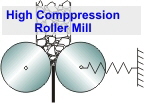|
In the provided diagrams the following parameters are shown in relation to the specific grinding force Fsp:
mass related energy absorption of the High Compression Roller Mill EM (in the diagrams of Schwechten named WM*) relative gap width s produced portion of fines below 0,04 mm, f40 (an already included portion of fines below 0,04 mm in the feed material was subtracted) specific grinding energy for the production of fines below 0,04 mm, WM,40 = EM/f40 optimization factor for the closed circuit grinding below 0,04 mm, WM,40/f40
Further on selected particle size distributions of the feed material and the mill product are shown.
An optimization of a closed circuit grinding cannot be done only in terms of minimized specific energy consumtion but must take into account the
size of the mill, of the deglomerator and of the classifier which is determined by the production of fines and the resulting circulating load. If for instance WM is reduced with decreasing specific grinding force then also the production of fines decreases and the circulating load of the milling circuit will increase. A compromise has to be found.
A rough indicator for this compromise is the quotient (WM/f) which takes into account the specific energy consumption of the mill as well as the production of fines.This quotient is just a helping parameter.
A real optimization must consider the energy demand of the deglomerator, the classifier and the transport systems as well as the necessary capital
expenditure for the mill and the other machines of the grinding circuit. This cannot be done here. The minimum of the helping parameter (WM/f) just leads to that specific grinding force at which the specific energy consumption of the mill related to the production of fines is at the lowest.
|



